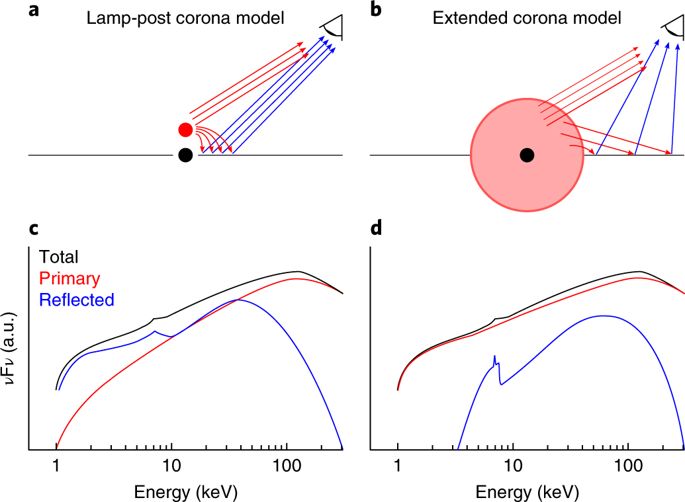X線偏光から得られたブラックホール連星はくちょう座X-1への降着の幾何的構造
Accretion geometry of the black-hole binary Cygnus X-1 from X-ray polarimetry
2018年6月25日 Nature Astronomy 2 : 6 doi: 10.1038/s41550-018-0489-x

ブラックホール連星(BHB)は、恒星質量ブラックホールと、すぐ近くを軌道運動している伴星から構成される。伴星から放出された物質は、ブラックホールへ輸送され、降着円盤、コロナ、そしてジェットの構造を形成する。物質が解放する重力エネルギーは、X線として放射される。その放射は特殊および一般相対性理論の効果による影響を受けていることから、もし降着の幾何学的構造が適切に同定できれば、ブラックホールやその周辺環境の特性を探る手段となる。スペクトルと時間変動の観測から、BHBの硬いスペクトルの状態における降着円盤-コロナの幾何的構造には、現在2つの競合するモデルが提唱されている。円盤で反射された硬X線の偏光を観測することができれば、この幾何学的構造を1つに決定可能である。2つの競合モデルでは、想定するコロナの広がりの違いから、相対論的な効果の強さ(たとえば偏光度の増加や偏光角の回転)の影響が異なる。本論文では、硬いスペクトル状態のBHBである、はくちょう座 X-1 からの硬X線放射(19〜181 キロエレクトロンボルト)の直線偏光を観測した結果について報告する。観測値は、8.6パーセント未満の低い偏光度(90パーセントの信頼水準での上限)と、ジェットの軸に揃った偏光角であり、硬X線放射のほとんどは強い重力の影響を受けていないことを示した。従来のスペクトルと時間変動のデータとともに考慮すれば、今回の結果から、硬いスペクトル状態にあったはくちょう座X-1において、降着円盤のコロナは広がった構造であるか、またはブラックホールから遠く離れたところに位置しているかのどちらかであることが明らかになった。
Corresponding Author
Black hole binary (BHB) systems comprise a stellar-mass black hole and a closely orbiting companion star. Matter is transferred from the companion to the black hole, forming an accretion disk, corona and jet structures. The resulting release of gravitational energy leads to the emission of X-rays1. The radiation is affected by special/general relativistic effects, and can serve as a probe for the properties of the black hole and surrounding environment, if the accretion geometry is properly identified. Two competing models describe the disk–corona geometry for the hard spectral state of BHBs, based on spectral and timing measurements2,3. Measuring the polarization of hard X-rays reflected from the disk allows the geometry to be determined. The extent of the corona differs between the two models, affecting the strength of the relativistic effects (such as enhancement of the polarization fraction and rotation of the polarization angle). Here, we report observational results on the linear polarization of hard X-ray emission (19–181 keV) from a BHB, Cygnus X-14, in the hard state. The low polarization fraction, <8.6% (upper limit at a 90% confidence level), and the alignment of the polarization angle with the jet axis show that the dominant emission is not influenced by strong gravity. When considered together with existing spectral and timing data, our result reveals that the accretion corona is either an extended structure, or is located far from the black hole in the hard state of Cygnus X-1.

